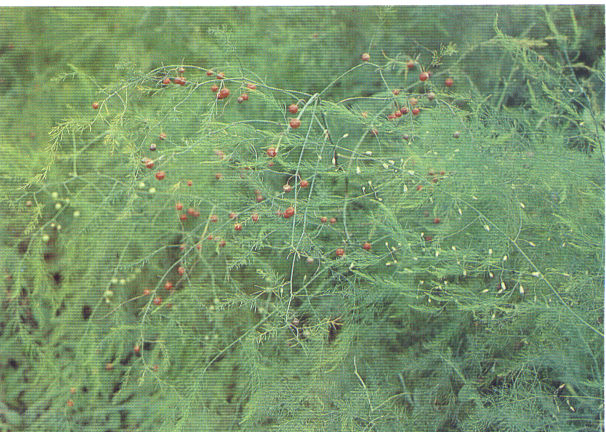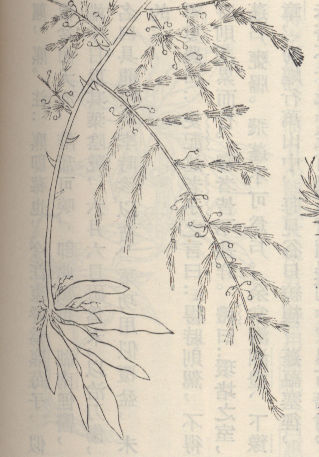| title | Asparagus Root |
| source | Jade Knock Studio |
Asparagus Root is the dried tuberous root of the plant Asparagus cochinchinensis (Lour.) Merr. from the Lily Bulb family. Asparagus Root is mainly produced in Meitan, Chishui, and Wangmo in Guizhou; Neijiang, Luzhou, and Leshan in Sichuan; Fuling in Chongqing; Baise and Luocheng in Guangxi; Pingyang and Jingning in Zhejiang; Weishan Yi Autonomous County and Binchuan in Yunnan, among other provinces and regions. Additionally, it is also produced in Shaanxi, Gansu, Anhui, Hubei, Hunan, Henan, and Jiangxi. The Asparagus Root produced in Yunnan, Guizhou, and Sichuan is mostly distributed through Sichuan, hence it is referred to as "Sichuan Asparagus Root." However, Guizhou has the largest output, so modern materia medica often identifies Guizhou as the authentic production area of this herb.


bubble_chart Varietal Examination
The "Shuowen" states: "Qiang, Qiang Mi, is Men Dong." The "Erya" concurs. The "Shan Hai Jing: Zhong Shan Jing" says: "Five hundred li to the northeast is Tiaogu Mountain, where the trees are mostly locust and tung, and the grasses are mostly Peony Root and Men Dong." Guo Pu notes: "The Bencao Jing says, Men Dong is also called Man Dong, now written as Men, commonly as Er." According to the Bencao Jing, Asparagus Root and Ophiopogon Tuber are two different things, and neither has the alias "Man Dong." Therefore, Hao Yixing's "Erya Yishu" believes that "Qiang Mi, Men Dong" actually refers to roses and has nothing to do with Tian and Ophiopogon Tuber. According to his explanation, Tian and Ophiopogon Tuber should not be written as Tian and Mai Men Dong. Current research on the Wuwei Han Dynasty Medical Slips also writes it as "Men Dong," which serves as evidence. As for Li Shizhen's statement: "Grasses that are lush are called Men, commonly written as Men. This grass is lush and has the same efficacy as Ophiopogon Tuber, hence it is called Asparagus Root." This statement is incorrect.
The "Erya·Shicao" has a separate entry that states: "Mao, Dianji." Guo's annotation says: "It has fine leaves with thorns, is a vine, and is also known as Shangji. The 'Guangya' calls it the female wood." Checking the 'Guangya', it says: "Dianji, the female wood." The 'Guangya Shuzheng' notes: "The 'Yulan' quotes Sun Yan's annotation: also known as Bai Ji. The 'Shennong Bencao' says: Asparagus Root is also known as Dianle. Le and Ji are ancient homophones; Dianle becoming Dianji is like in the 'Xiaoya Siggan', where 'like arrows, like Ji', the 'Han Shi' has Ji as Li. The 'Mingyi Bielu' says: Ying Shi is also known as Niu Le, also known as Shan Ji. This is also the same." According to the 'Bencao Jing', Asparagus Root is "also known as Dianle". Tao Hongjing quotes the 'Bowuzhi' as saying: "Asparagus Root has reverse thorns when stroked against the grain. If the leaves are smooth, it is called Chixiu, also known as Dianji, and can be used to wash silk, making it white like velvet. People in Jincheng call it washing grass. Breaking its root and kneading it in warm water can wash clothes better than ash. This is not Men Dong, but similar." He also quotes the 'Tongjun Yaolu' as saying: "The leaves have thorns, it is a vine, flowers white in May, fruits black in October, with roots connected in dozens." Although the 'Bowuzhi' says that the washing grass is not Asparagus Root, Tao Hongjing says: "According to this, what people collect today all have thorns, originally named Dianle, also roughly similar, and can wash dirty clothes clean." He also says: "This is very confusing, and there is no longer Men Dong, perhaps Men Dong is a different species, not the washing grass." But in fact, the plant that Zhang Hua and Tao Hongjing referred to as being able to wash clothes is likely the Asparagus genus of the Lily Bulb family. The roots of this genus are rich in steroidal saponins, which can reduce the surface tension of water solutions, causing them to produce a large amount of persistent foam when shaken, a property that ancient people used to wash clothes. Comparatively, the 'Xinxiu' is more reasonable: "There are two types, one with thorny and astringent seedlings, and one with smooth and thornless seedlings, both are Men Dong. Commonly known as Dianci and washing grass, named by their appearance, although there are several names, they are ultimately the same thing. Both roots can wash dirt clean, Men Dong and washing grass are interchangeable names." However, the specific plant species referred to in each book is actually unknown. The thorny one might be the genuine Asparagus Root Asparagus cochinchinensis, while the thornless one might be something like the dense-toothed Asparagus Root Asparagus meioclados Levl.The "Bencao Tujing" describes Asparagus Root: "In spring, it produces vines as thick as hairpins, growing up to several meters tall. The leaves resemble fennel fruit, extremely sharp and smooth, with reverse thorns, though some are astringent and thornless. The leaves are like fine cedar, scattered and thin, all called Asparagus Root. In summer, it produces small white flowers, sometimes yellow. In autumn, it bears black seeds near the roots. After the summer solstice, it no longer flowers, but secretly produces seeds. The roots are white or yellow-purple, as thick as a finger, two to three inches long, with larger ones being superior, somewhat resembling stemona root." Su Song's description clearly refers to plants of the Asparagus genus, but among the six illustrations, the "Yanzhou Asparagus Root" is a stemona root plant; the "Xijing Asparagus Root" is a dicotyledon, as mentioned in the "Tujing": "Those from Luozhong have large leaves and thick stems, quite different." According to the "Research on the Sorting and Quality of Commonly Used Chinese Medicinal Materials" (Southern Collaboration Group, Volume 4), it is suspected to be a plant of the Araliaceae family, likely a misused species at the time. The other four Asparagus Root illustrations may belong to the Asparagus genus, but their morphological characteristics do not match the current standard Asparagus cochinchinensis. The "Zizhou Asparagus Root" resembles Asparagus filicinus, while the "Jianzhou Asparagus Root" is similar to the climbing Asparagus brachyphyllus Turcz. As for the "Wenzhou" and "Hanzhou" Asparagus Root, their species are difficult to determine.
In summary, we believe that the Asparagus Root recorded in historical literature has always been dominated by plants of the Asparagus genus, but its sources are complex. The identification of Asparagus cochinchinensis as the standard species is likely related to the cultivation practices in major production areas.
bubble_chart Local History
The plants of the genus Asparagus are widely distributed. The tuberous roots of various species in this genus may be used medicinally as Asparagus Root at different times and in different regions. As stated in the Bencao Tujing, "It is found everywhere today," but due to the differences in varieties across regions, early records such as the Shiji generally should not be used as the basis for identifying the authentic variety Asparagus cochinchinensis. This confusion even persisted into more recent times. For example, the "Yaowu Chuchan Bian" states that "those produced in Sichuan are the best," while the "Medicinal Materials Regulations" of the Xi'an City Traditional Chinese Medicine Business Association in Shaanxi Province in the 29th year of the Republic of China (1940) states under the Asparagus Root entry: "Produced everywhere, with those from eastern Zhejiang being the best." Modern standards generally determine Guizhou and Sichuan as the authentic production areas based on the distribution and cultivation history of this species.






